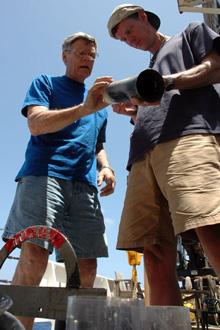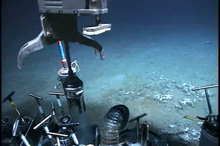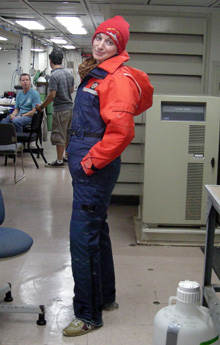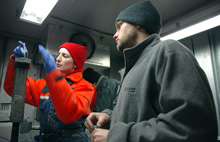Guy Telesnicki and Harry Roberts discuss the best way to mount the push cores in preparation for the first Jason remotely operated vehicle (ROV) dive of the cruise. The easiest and most effective way to accomplish many tasks at-sea isn’t always the high-tech solution. For this cruise, we used the tried-and-true method of mounting every set of nine cores in old milk crates. Each crate was then attached to Jason, using screws or bungee cords. Click image for larger view and image credit.
During Jason Lowering #275, the ROV's manipulator arm reaches for another push core. Click image for larger view and image credit.
Chillin' in the Gulf of Mexico
July 5, 2007
Kate Segarra
University of Georgia
26° 22.98 N
94° 31.56 W
Those crazy microbiologists are at it again. It’s July in the Gulf of Mexico and the ambient temperature is greater than 30º Celsius (85º Fahrenheit). So why is Kate Segarra wearing a wool hat and snowsuit on top of a fleece vest, long pants, and a scarf? You might wonder if the ship’s air conditioning is working overtime . . . and you’d be right! But that’s not the reason for Kate’s fashion choices.
She’s suiting up to work in the “cold room,” which is essentially a walk-in refrigerator, or reefer (for you nautical types). She and the rest of the researchers from Dr. Mandy Joye’s lab at the University of Georgia will spend hours at a time in there, processing sediment cores for microbiological and biogeochemical assays.
The Joye Lab group of geomicrobiologists is focused on the "biogeochemical engine" that powers these seep communities. They study it by comparing rates of microbially mediated sulfate reduction, anaerobic oxidation of methane, and methanogenesis, as well as geochemical profiles in the sediments all of the various sub-habitats encountered on the deep slope.
These sub-habitats include brine pools, mud volcanoes, urchin beds, pogonophoran worms, bacterial mats, asphalt, and oil seepage sites. Because the seep communities surveyed on this cruise are in such deep water, they are accustomed to a relatively stable temperature of about 4º C (39º F).
Kate proudly dons her Mustang suit in preparation for a few chilly hours processing samples in the walk-in “cold room.” Click image for larger view and image credit.
If you need to find one of the geomicrobiologists during the cruise, the "cold room" is the first place to look. Kate Segarra (left) and Marshall Bowles carefully sampled dozens of cores during the 33-day cruise. Click image for larger view and image credit.
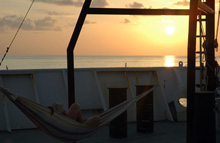
After working through the night to process samples, one of the scientists collapsed in the hammock on the bow of the research vessel Ronald H. Brown. Click image for larger view and image credit.
Additionally, the relatively high availability of carbon in these environments supports high levels of microbial activity, which consume all available oxygen within the top few millimeters of sediment. Therefore, researchers must go to great lengths to mimic the benthic conditions of the ocean, keeping the sediment samples cold and out of contact with the atmosphere. Once the remotely operated vehicle Jason or the elevator brings the sediment cores on deck, they are immediately taken to the cold room.
Once there, the cores are removed from the sampling rack and capped on either end to limit exposure to oxygen. Photos are taken to record the size of the core, as well as any color changes and layering. Overlying water is sampled with a gas-tight syringe and capped.
The cores are then extruded — pushed up from the bottom and out the top of the core tube — exactly like those ice cream Push-Ups. As the sediment core is exposed, three-centimeter sections are removed and purged with argon gas (to remove any oxygen) before being processed for a suite of geochemical parameters and rates of microbial activity. As many of the microbial processes occurring in these sediments are inhibited by oxygen, it is critical to work quickly to ensure that the samples remain anoxic (without oxygen).
At near freezing temperatures, researchers find that maintaining dexterity and speed can be difficult — but it’s all in the name of science!
































